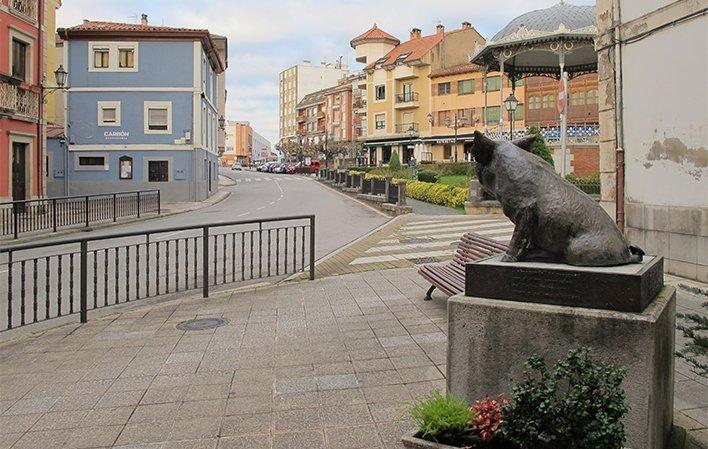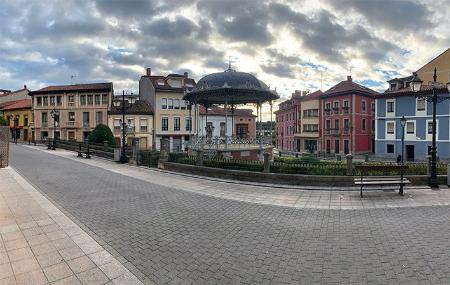
The Gochín of Noreña
- Address Noreña and Gijón Asturias Centre
- Distance Distance: 26 kms
- Difficulty Difficulty: Short
- Mountain bike Mountain bike: Half day
- Start point Start point: El Berrón
- Route type Route type: mtb
- Tour type Tour type: Linear
- Layout of the route Layout of the route: Download kml, Download gpx
Route
El Berrón (Noreña) - Gijón 26
Non-circular route starting in El Berrón, in the heart of the council of Siero, and ending in Gijón. It is recommended for children and novice cyclists as it is not particularly difficult. It is precisely on the descents where you have to pay more attention. Suitable for all types of bicycles. And as you know: Whoever sees the gochín, has to kiss him on the back! So, it is a route for entertaining cycle touring, avoiding the usual Alto de La Madera, which runs through a surprising rural environment among lemon trees and granaries.
From El Berrón we leave in the direction of Buenavista to cross the N-634 a little further on, entering Noreña in front of the town hall, to stop a few metres later at the point that gives the route its name: the Monumento al Gochín (pig). It is a life-size bronze statue of a pig on a pedestal, which aims to extol the figure of this animal, which is eaten "up to its feet". Noreña stands out for the meat industry that is established in the area and for its associated gastronomy: tasty tripe, pig's trotters, chorizo sabadiegos (sausages)?
Next to it is the Quiosco de música: it is one of the oldest works of iron architecture in the council. The old Plaza Mayor, now Paseo de Fray Ramón, with its gardens and its airy bandstand, is still the setting for the town's musical activities and a place for social gatherings. Shortly after resuming our walk, and as the route is about to leave Noreña, our attention will be caught by the sight of a clock-tower leading to the palace of Rebollín. The clock-tower, nowadays fitted out for cultural purposes, dates from the 17th century and had functions related to municipal power: neighbourhood meetings, prison, stable or warehouse. The tower clock has been used to control the working hours in the workshops and activities of the town, by means of the sound of its bell and also because it is visible from many points of the town.
The Rebollín Palace, built between the 16th and 18th centuries, was the seat of powerful Asturian families such as the Argüelles (the original family), the Llanes and the Quirós. This building is a great example of Asturian palatial construction. The exterior, of simple monumentality, has the coats of arms of the Argüelles and Argüelles-Quirós families on its main façade. Two large arches, placed above plain imposts, lead to the entrance hall.
The route continues between various chalets and houses of varied aesthetics, which, as you go deeper into the valley, change into traditional village houses with their granaries and bread baskets from which hang strings of onions, corn panoyas and some beans that are dried in the air. A true immersion in the most traditional agricultural and livestock farming style of the Asturian countryside. On this dive we cross places such as Poladura or Huergo, where we can see the solitary hermitage of San Ananías in the vicinity.
After a significant descent, we reach the valley of the river Pinzales, where we will follow the railway line and the river to Sotiello, passing near La Aguda, Peñaferruz or Pinzales. On this path you can make out the bell tower of the Abbey of San Juan Bautista, with the centenary texu (yew tree) that protects it with its extensive shade. And if you take this walk at the right time of year, you can enjoy the fragrant aroma of the lemon trees, laden with their fruit and whose yellow colour fills your mind with citrus and summery tints.
Such is the state of peace and amazement that you reach on this journey that not even the arrival in Gijón through an increasingly industrial and urban landscape in the surroundings of the Somonte industrial estate and the Tremañes neighbourhood, through which you enter the city, will be able to undo it. After walking along the comfortable cycle lane of the Moreda park, you reach the Gijón train station, the end point of this route.
Map
Itinerary
El Berrón - Noreña - Palacio del Rebollín - Poladura - Pinzales River Valley - Sotiello - Gijón


